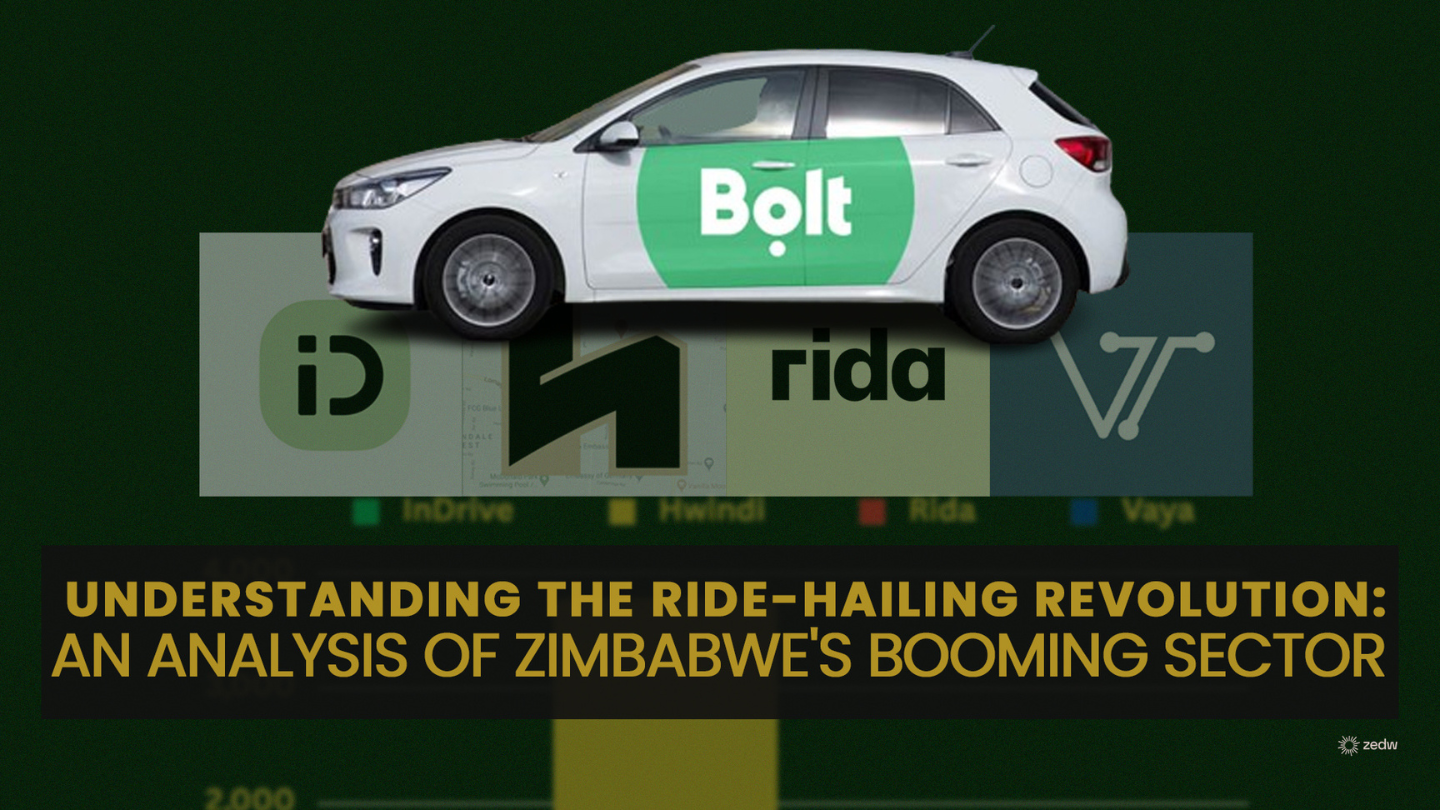“Hwindi used to offer the best payouts but since Rida and InDrive came into the equation they’ve had to go lower. The apps are now more or less in the same range now…” This was one of the insights my InDrive driver shared with me on a recent trip… You see something interesting is happening in Zimbabwe. There’s a battle going on between ride-hailing companies and consumers are reaping the benefits.
The most recent entry in this space is Bolt (formerly Taxify), which is now advertising for driver sign-ups on Facebook. This comes at a time when InDrive and Rida (other recent entrants) have been pursuing hyper-aggressive marketing strategies suggesting that the competition in this space is getting tougher.

At the moment, Bolt is only recruiting drivers in Zimbabwe but has yet to make service available to passengers. I could set up an account on the application but when trying to order a ride, I was met with an error message noting that “Bolt is not yet available here”. Nonetheless we will still explore the current state of ride-hailing in the market along with what the service potentially has to overcome if it is to enter the market…
Ride-hailing in Zimbabwe – A Brief History
Uber-like transport on-demand services aren’t new to the market. As far back as 2016 there was a battle for market share, with Rwanda’s 250Taxi (later AfriTaxi) launching 263Taxi in Zimbabwe. It never took off as local companies like GTaxi and Hwindi simply understood the market better and had been here for longer.
In 2018, we saw the introduction of Vaya. The common consensus at the time was that because this was a subsidiary of one of Zimbabwe’s largest companies (Econet) it would blow competition out of the water. By this time GTaxi had lost some of its luster. Hwindi was still going strong and it was basically seen as a two-horse race between Vaya and Hwindi.
Whilst Vaya fully embraced the internet and an uber-like model, Hwindi was more pragmatic about the market it was involved in and also offered users the ability to book rides via WhatsApp/call-in to ensure service could be delivered even during outages or downtime. Interestingly, Hwindi’s business development executive, Patrick Manyangadze noted that they later ditched that approach because it was too resource intensive relative to the revenues it was generating.
2018 and 2019 were challenging years for ride-hailing service providers. In addition to an economy in freefall, fuel shortages and constant power outages led to network inconsistencies. Providers were having to attend to problems they did not create.
It was during this period that InDrive (known as InDriver at that time) entered the market. Their call-to-fame, a feature allowing passengers to negotiate a fare with their drivers, was already a part of this version of the application but at the time it wasn’t really a hit with consumers. The pandemic in 2020 and the following year meant there wasn’t much to talk about regarding the ride hailing services – beyond the fact that Hwindi and Vaya drivers were also classified as essential service providers or worked in tandem with businesses that needed logistics partners.
InDrive was reintroduced to the Zimbabwean market in March of 2023, and at the time of relaunching the service provider claimed their drivers wouldn’t be charged commissions for the first six months. Until present, InDrive and potentially Bolt will be not collecting any commissions allowing them to offer the service at a more competitive price initially. Rida which relaunched in September of 2023 also deployed the same strategy of foregoing its own commissions and employing hyper-aggressive marketing campaigns to ensure they gain market share. This model has some problems which we will explore later…
Competition – great for consumers, not so great for businesses (and drivers)
InDrive’s aggressive push signaled a new era. The ride-hailing startup announced its Zimbabwean launch with digital marketing campaigns and took it a step further by taking up space on billboards and one would hear their campaigns on local radio. InDrive it seemed left no stone unturned. Rida followed in their footsteps with an aggressive campaign of their own with both services promising best-in-class pricing. Interestingly, the local providers – Vaya and Hwindi- seemed to have become less aggressive in their marketing efforts over the past year in response to the new entrants.
For us as a local company, with limited resources, we can’t afford to fight these guys. They are multi-million-dollar companies and so we can’t go ad for an ad against them. You have to remember that these companies have no local presence, employees, rentals, or tax burdens, and so they have no expenses beyond the ad-campaigns for Zimbabwean market.
Patrick Manyangadze Hwindi Exec


Whilst the aggressive marketing of Rida seems to be paying off with increasing search density over time, the presence of more ride-hailing services seems to be driving pricing down – a sentiment commonly shared by drivers.
Beyond pricing, another point of similarity is that it appears that most of the drivers on the ride-hailing apps drive for multiple services. In my conversation with one driver, he highlighted that drivers are using all the apps concurrently. “When I accepted your trip request, I had to close the three other apps quickly so I would stop getting notifications from them.”
Does Zimbabwe’s terrible transport situation create a market?
This tight competition means customers now have a bevy of “low-cost” ride-hailing options to choose from. I say low-cost but in truth most Zimbabweans simply cannot afford to use these applications regularly. Zimstat data suggests that more than 50% of Zimbabwe’s formally employed workforce is now earning less than $20/month, so ride-hailing is out of the reach of many.

Where an incentive has been created for low-cost ride-hailing though is for the intersection of people who don’t have personal vehicles or don’t want to use them and are fed up with Zimbabwe’s terrible public transportation.
Following a clamp down on omnibus operators during the pandemic, the number of options available to citizens dwindled from 50,000 omnibuses on Zimbabwean roads pre-pandemic to about 1,500 operators by mid-2021.
The gap has been filled by Mshika-shikas (informal taxis) that offer a service I wouldn’t wish on my worst enemy. The mshika-shika experience includes being one of nine passengers in a car designed to carry 5, having a driver who is allergic to obeying road rules, and a possible safety risk as some of the passengers of these vehicles have been victim of theft. For the privileged few who have disposable income, the ride-hailing options will be the only choice until Zimbabwe’s bus-deficit and subsequent transportation problems are solved.

What are the questions new entrants have to answer?
It’s hard not to see Bolt’s possible entry into this space as anything other than a negative for existing companies (and drivers). This will be yet another rival who will drive prices further down. For consumers though, cheaper pricing will make the services more attractive in the short term but there are some common shortfalls observable regarding new entrants.
Because of Zimbabwe’s heavy cash-reliance another question that comes up frequently is how each provider gets to collect their money from drivers? A source with industry knowledge explained that the commissions are collected through two main ways. Some of the ride-hailing apps have wallet functionalities that require drivers to prefund wallets and then commissions for each trip are deducted from that wallet. Other applications require drivers to have a debit/credit card where commissions are deducted and whenever the card has no available funds the driver is unable to accept ride requests.
One example of the differentiators between local and foreign-owned ride-hailing companies is the approach to payments. You can tell providers like Hwindi and Vaya understand the market because there are always local payment options available to drivers. Hwindi for example incorporates payment options that include Paynow, InnBucks, EcoCash and then debit/credit card options whilst a service like InDrive is limited to cash or debit/credit cards.
This on the ground approach extends to car inspections – for service providers like Vaya and Hwindi a lot of care and attention is put on the state of the cars that passengers interact with, with inspections being regular. With InDrive I’ve had instances where a car I’m sure doubles as a Mshika-shika came to pick me up after a request. Those are some of the details that foreign-providers miss that local competitors and more importantly, passengers who use the service pick up on.
Other big challenges that require on the ground context to grasp include network and mapping issues:
One of the biggest challenges in our industry at the moment is network availability issues. Because of power cuts, when drivers get to certain areas, their application stops working because they no longer have internet access. When the network goes down, the drivers start getting lost, and apps go down for both drivers and passengers. Another issue is the mapping. For other areas, our maps will show coordinates instead of the roads, some areas are wrongly placed on maps or are even not there, so drivers have a hard time getting to places again.
Patrick Manyangadze, Hwindi Executive
Questions also linger around the models. When new entrants arrive into the market they undercut existing competition and drive prices down – choosing to forego their commissions and revenue in order to gain market share in the short term. The only problem with this is, because passengers are price sensitive, when the eventual price hikes kick in, usage crumbles. With pricing for InDrive already going up and now seemingly higher than every other competitor except for Vaya. This is already a far cry from when they started and were undercutting local offerings. Once the services add a commission someone will have to take a hit. Either the passengers or the drivers – sometimes both.
Whilst there seems to be a scramble between service providers in Zimbabwe’s ride-hailing space, a lot of questions remain unanswered regarding how big the pie is and whether there are currently enough passengers to build viable and more importantly, multiple businesses in this space…








